Displaying items by tag: America's cup
'Sir Ben' Backs British Entry In America's Cup - But May Not Lead The Crew Himself
#AmericasCup - Olympic sailing legend Sir Ben Ainslie confirmed his backing of a British contingent among the six entries in the next America's Cup, as announced at a press conference today.
But it's not yet confirmed if he will be one of the crew on board, as he was when he helped Oracle Team USA to the 'Auld Mug' almost a year ago.
Bloomberg has more on the press gathering in London, at which Ainslie spoke of his wish to "bring the America's Cup home" when the yachts get racing in 2017 at a venue still to be decided after Team Australia pulled out over the summer.
Indeed, next time out 'Sir Ben' will go head to head with the team he led to a remarkable comeback victory last year in San Francisco.
However, as the Western Morning News reports, the Olympian is was tight-lipped about his own involvement on the team, only commenting that it would be "predominantly British" and would comprise "experienced guys who have been successful in the cup and some younger talent coming through, particularly British talent."
He added: "If we were going racing tomorrow I would be steering the boat but that might not be the answer in a couple of years’ time."
'Bart' Simpson Inquest Rules Accidental Death
#AmericasCup - An inquest into the death of Andrew 'Bart' Simpson while training for the America's Cup last summer has ruled the tragic incident as an accident, as the Bournemouth Echo reports.
The sailing world was shocked a year ago by the loss of the British double Olympic medallist, who became trapped underneath the capsized Artemis Racing AC72 catamaran he was crewing with 10 others in San Francisco Bay.
Last October the official medical examiner's report found Simpson's death was caused by "blunt trauma and drowning" after the vessel capsized and broke apart, dealing him multiple blows to the head.
Statements read out at Bournemouth Coroner’s Court described the scene as Simpson's teammates and emergency workers made desperate attempts to free him from under the wreckage, but he was pronounced dead at the scene.
In his conclusion of accidental death, Dorset assistant coroner Richard Middleton said that he was satisfied the cause of death "arose directly as a consequence of some deliberate human act which had unexpectedly and unintentionally taken a turn which had led to his death."
The Bournemouth Echo has more on the story HERE.
Sir Ben Wants To Swap The Seas For The Skies
#AmericasCup - Having already mastered the seas, now British Olympic and America's Cup hero Sir Ben Ainslie wants to conquer the skies.
The Bournemouth Echo reports on his recent appearance on BBC Radio's Desert Island Discs, where he expressed his desire for his very own flight simulator to practice with, as he lacks the time to properly pursue the flying lessons he's already started.
Sir Ben also spoke of scaring himself by his competitive nature and dark moods after race losses, but at the same time confirmed he's driven by "one burning desire" - to win the America's Cup with a British team and repeat last summer's leading of Oracle Team USA to an amazing against-all-odds comeback victory.
With organisers proposing a 'nationality rule' for the next America's Cup, Ainslie's dream may come sooner than later - and he's got at least one major supporter in superstar Formula 1 car designer Adrian Newey.
'Nationality Rule' Proposed For Next America's Cup
#AmericasCup - Sir Ben Ainslie's historic contribution to Oracle Team USA's astonishing turnaround victory in this year's America's Cup may prompt a future rule change for the yachting classic - one that would prevent its likes from happening again.
The British Olympic hero's last-minute addition to the faltering American team saw their fortunes change almost instantly as they battled against the formidable Emirates Team NZ on San Francisco Bay, fighting back from an eight-to-one deficit in the first-to-nine contest to clinch dramatic victory from the jaws of defeat.
But as a new Yachting World interview with Oracle Team USA's chief executive Russell Coutts reveals, a 'nationality rule' - that would restrict teams to sourcing their crew from the country they represent - could be on the cards for future editions of the 'Auld Mug' challenge.
According to Coutts, both Oracle Team USA and the Challenger of Record (Hamilton Island Yacht Club in Queensland, Australia) are "considering options there".
That's one of many changes proposed for the America's Cup, aside from moves to reduce costs of competing and encourage more nations to be represented at what Coutts describes as "the pinnacle of our sport".
Meanwhile, San Francisco's SFGate.com reports that the latest edition of the America's Cup did not bring as much economic benefit to the Bay Area as has been expected.
Figures apparently show that the races and associated developments generated up to $550 million, which falls far short of the $900 million forecasted two years ago.
And that's in addition to costing the city's taxpayers some $5 million, funding that some city officials believe could have been better spent elsewhere.
SFGate.com has more on the story HERE.
Bob Fisher, leading sailing writer and the supreme authority on the America's Cup, brought an inspiring vision of the highest peaks of the sport to the Royal St George YC's 175th Anniversary Champions Celebration last weekend. W M Nixon delves into the backstory of one of global sailing's true greats.
#americascup – There's a dilemma underlying the remarkable career of Bob Fisher. He is one of the best sailing writers in the world. He is probably the very best writer about yacht racing in the world. And he is the undisputed global authority on everything to do with the America's Cup – its history since the first race in 1851, its litany of extraordinary characters with their many wrangles, its technical advances, and its remarkable and sudden ultimate rise to become an event of truly global status during the 34th Series in September 2013 in San Francisco.
The dilemma? Well, The Fish is a true sailing polymath. For sure, he writes vividly about our sport. Yet he is also a talented racing dinghy builder – his own-built boats have won championships to international level. But he is also an extremely good sailor himself. Thus in his long career of writing about sailing, he has probably been a better natural racing sailor than about 98% of the people whose sailing achievement he happens to write about.
All of which explains his "absorbing interest" in the America's Cup, and his ability to produce the defining stories about it. For it is only at the America's Cup that Bob Fisher is best deployed as the reporter, commentator and historian while others do the sailing.
At other events during his long and varied career - he is now 77 - he has often been an active and successful participant in addition to being the man who files the stories at the end of the day's racing. And with this frequent personal involvement in the racing afloat and the apres sailing ashore, sailors see him as one of their own rather than a media person of whom they should be wary. Thus he can come up with the true inside stories which bring his words to life, raising them above reportage to become the vivid defining narrative of sailing as it really is.
Quite how he manages to do it is beyond most folk's imagination. He is doing enough to provide about half a dozen people of more ordinary energy levels with full time careers. Yet although there must have been times when the pace verged on being too hectic to handle, when you meet him participating and reporting in sailing events, or at a special sailing social gathering like the 175th Anniversary Champions Party at the Royal St George YC, it is to find you are undoubtedly in the presence of a great man, but also a man who enjoys it all to the full, with wide and civilised interests in many aspects of human life.
The notion of the 175th Anniversary of the Champions of the George originally came from Johnny Ross Murphy, and when he got friends and fellow members like the master-delegator Brian Craig, plus Derek Jago and Paul Maguire on side, the thing just grew and grew until with a group chaired by Craig, with the efficient Ciara Dowling making sure the nuts and bolts were in place, they worked at a list of who was eligible to be there.
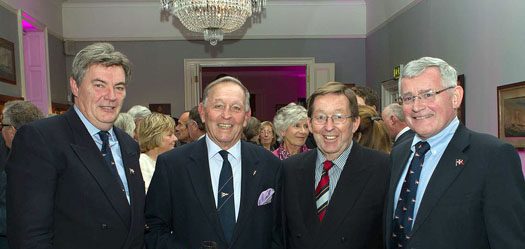
At the Royal St George YC 175th Anniversary Champions Night were (left to right) Don O'Dowd (Rear Commodore (Sailing) R StGYC), Bob Fisher, Winkie Nixon, and Commodore Liam O'Rourke. Photo: Gareth Craig
They managed to go back 62 years, and the final total was 597 major winners of one sort or another, from Dublin Bay champions right up to ten Olympic sailors. On the night, the target figure of 250 attendees had been long since surpassed, and with diligent research they had unearthed some top performers from a very long time ago. Yet it was also very much of today, for even as we reviewed the achievements of 175 years, we were also thinking of RStGYC member Adrian Lee already on his way to establishing the new course record with his Cookson 50 in the 360-mile mile Dubai to Muscat Race, which had started that morning – his success raised the RStGYC major achievement tally to 598 almost before the party was over. At the same time, fellow member Damian Foxall was in Le Havre awaiting the start of the Transat Jacques Vabre 2013 as co-skipper on the MOD 70 Musandam-Oman, but Foxall had to go through frustrating days of waiting as the raced wasn't to start until Thursday November 7th.
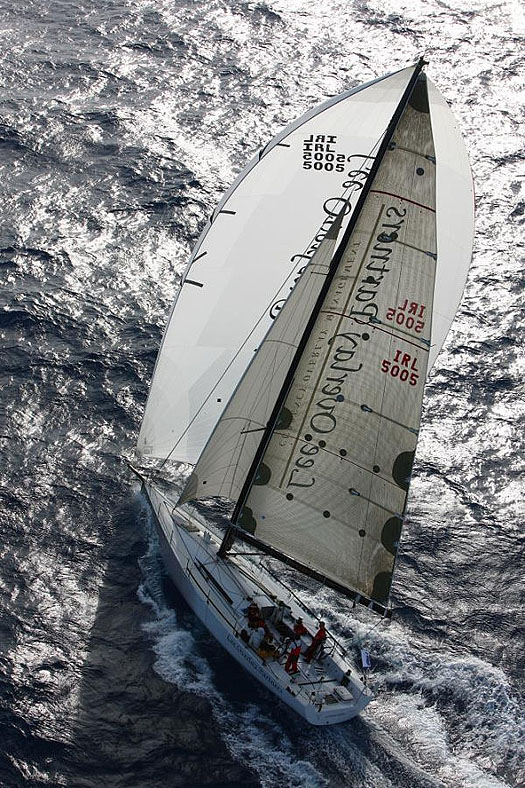
Even as the RStGYC 175th Anniversary Champions Party was under way, club member Adrian Lee was bringing the major achievements list up to 598 with his success in the Dubai-Muscat Race 2013 with his Cookson 50 Lee Overlay Partners. Boat and owner were already in the list with their overall win in the inaugural RORC Caribbean 600 Race in 2009. Photo: Tim Wright
It was quite a night in Dun Laoghaire, and with some crews reunited after more than three decades, there was a lot of catching-up to be done and news to be exchanged. So it says everything about Bob Fisher's ability to convey the new excitement of the current America's Cup that he was able to get the full attention of people in their sea of nostalgia, with his presentation provided an excellent spicing for an evening which would otherwise have been just too totally club-focused.
Sharing the round table at the inter-speeches supper with The Fish, we found topics covered were wide ranging and not necessarily entirely about boats and sailing. But nevertheless it is Bob's boat-owning history, and his uses of his boats, with which the ordinary sailing Joe can most readily identify.
The word is that just about all the Fisher myths are gloriously true. He did indeed absolutely have to sell his own-built championship-winning Fireball at a major event in Switzerland in the 1960s immediately after winning and before departing the hotel, as he and his crew had neither the money to pay the hotel bill (which was enormous, this was Switzerland after all), nor the funds to get themselves home.
He did indeed win his first race at his birthplace of Brightlingsea in Essex at the ripe old age of two years and three months (he was skipper, working mid-cockpit, while his father was detailed off to be the helmsman). And currently at his adopted home port of Lymington on the western Solent, he does indeed co-own with Barry Dunning the 1895-built 40ft Solent One Design Rosenn, the sole survivor of what was probably the world's first one design keelboat class.
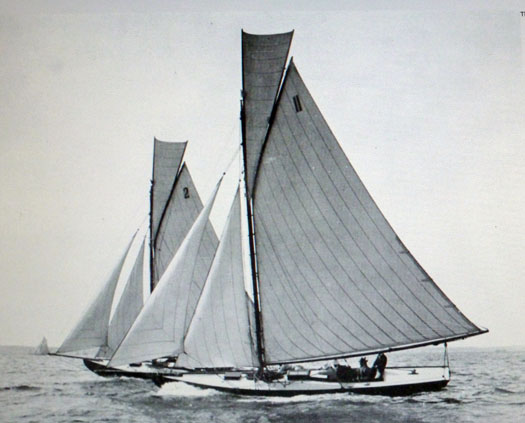
The Solent One Designs in their prime in 1895. They were probably the world's first proper one design keelboat.
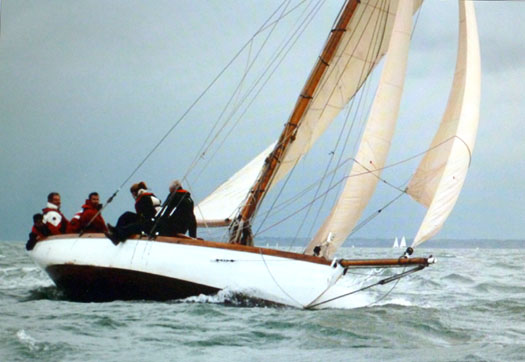
The survivor – Rosenn (Bob Fisher and Barry Dunning) is the sacred relic of the Solent OD.
Thus it's likely that Bob and I were the only two members of the Old Gaffers Association at the 175th anniversary party in the George, as he now owns two gaffers, having given in to his crew's demand that while they can go along with gaff rig, sometimes they'd like to sail a newer boat. So he has obliged them by getting a boat three years younger than Rosenn, a lovely little Fife boat built 1898 which he has in Scotland in readiness for next year's 40th Anniversary Scottish Series, an event with which Bob has been closely associated since its inception.
It's the Scottish Series of 1992 which provides me with the most vivid image of Bob Fisher. Back in the 1980s, he was sailing consultant to the BBC soap Howard's Way, which was about the people – some good, some less so – running an expanding boatyard on the Hamble. To keep the series alive, the producers were looking for a new storyline which would take things in a believable direction, yet provide fresh excitement and business and technical problems with which a wider audience could identify.
Bob suggested that they should get the "yard" to start developing the building of a new-style Ultra Light Displacement Boat, a boat which would be big enough to provide accommodation of family cruising appeal, yet allied to a performance which would, in the ideal ULDB conditions, attract flat out racing types keen for sheer speed. The theory was that the human challenge in a project so far removed from the orthodox European boat type would create its own dynamic and drama.
He was given 48 hours to put the idea in a more concrete form. Now it so happened that some time earlier, he and Tony Castro had been doing a China Sea Race on a Castro-designed 40ft ketch, and though they could get her above ten knots on a good reach, hitting 11 seemed to be an insurmountable barrier. So in their frustration some very rough ideas were sketched out for a ULDB which would simply keep on increasing speed as the breeze built off the wind.
The rough drawings had been put away in a drawer and forgotten about, but after this script conference, Bob immediately phoned Tony Castro and asked him if he could find those drawings, and if so could he develop them up into a workable proposition for the day after tomorrow. More than a little midnight oil was burnt, but Castro came up with the goods, and the result was Barracuda, the 45ft prototype of the ULDB which in production went through various name changes, and was finally series built by Sadler Yachts as the Sadler Barracuda 45, with 19 being produced between 1985 and 1989.
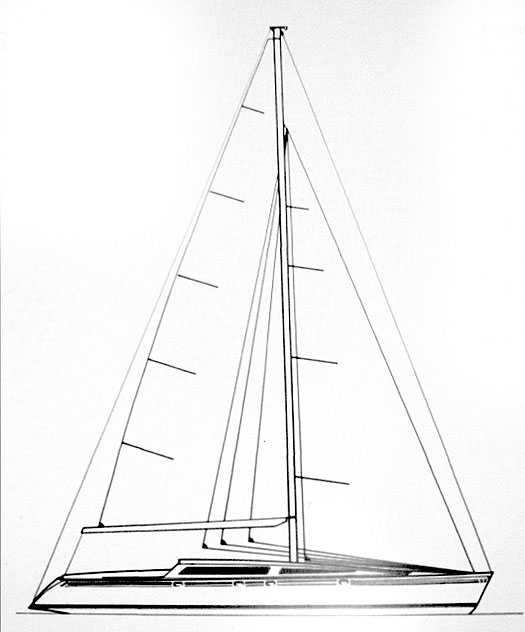
The above-water profile of the Sadler Barracuda 45 looked so normal it was a wolf in sheep's clothing, with the rig as shown only hinting at the fact that enormous masthead kites could be flown when conditions suited.
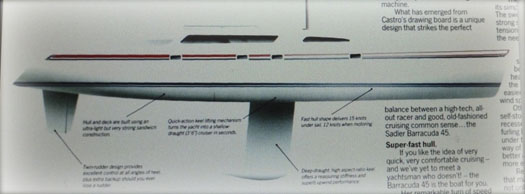
The hull profile gave a clearer indication of the boat's true character as a ULDB. The production boats had a hydraulically-raised keel, but Bob Fisher's prototype had a fairly straightforward heavily ballasted and very deep centreboard which was raised by a 3:1 tackle inside the centreboard case which was led to a winch on the cabintop. Two members of the crew were selected for the end-of-day centreboard-lifting grind with a double grip handle, and timed. The all-time record of 63 seconds was achieved by Bob and his exact contemporary Steve Lemon at Tarbert – "we wanted to get into the Islay Frigate asap"
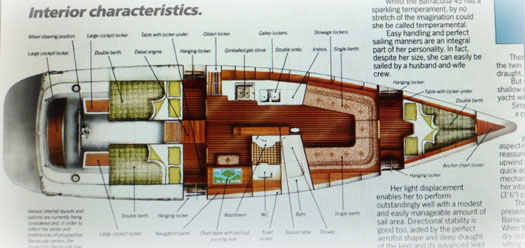
The accommodation layout of the production Sadler Barracuda 45 suggests that the builders were unable to resist filling every corner, whereas a true ULDB will have minimalist accommodation, kept strictly admidships. Although few if any of the buyers of the 19 production boats went for the bath option, their boats all came out at least a ton heavier than Bob Fisher's own Barracuda of Tarrant.
They were a complex build project, with a hydraulically lifting bulb keel which in theory came up far enough for the boat to dry out level, tri-podded on her keel and twin rudders. And with so much space in the roomy hull around the keel housing, they even suggested fiilling an under-utilised gap on the starboard side with a miniature bath, but it's thought that few if any owners availed of this option.
But the timber-built prototype Barracuda of Tarrant herself certainly did the business in developing the storyline for Howard's Way, and she also provided Bob and his wife Dee with ten extraordinary and hugely enjoyable years of active ownership in which they covered tens of thousands of miles thanks in no small part to Dee's exceptional organisational abilities, and her willingness to ensure personally that the boat was at the desired venue and race-ready when Bob arrived in from covering some major sailing event elsewhere in the world.
It says much about the boat's versatility that in 1989 she proved ideal for the two-handed Round Britain and Ireland Race. Sailed by Bob with Robin Knox-Johnston, she scorched round the 2000 mile course to such good effect that she won her class without recourse to handicap, and finished ahead boat-for-boat of the boats in the next two classes above. It made for a change from a previous participation by Bob in this race, when he and Les Williams raced an 80-foot maxi whose sails were so heavy that in each stopover port, they'd to organise a farewell party so that guests could be spirited aboard the big boat in order to help with raising the mainsail.
But Barracuda by contrast provided the perfect combination of long-legged performance with manageable handling loads on both sheets and helm. Thus she frequently made the annual trek round Land's End and north to the Clyde for the Scottish series, and 1992 was a classic example. The main start for the feeder race to Tarbert was from Gourock, and I was crewing for my brother in his Belfast Lough-based Sigma 33. Back in 1992, the Sigma 33s were superbly fulfilling the Offshore One Design ideal, and heading south for Ailsa Craig on a beam reach in a brisk westerly, as the sun set we were streaking out past the Garrock Heads with at least 16 Sigma 33s in line abreast under spinnaker to leeward, and a dozen or so others in close attendance.
Offshore racing gets interesting when the sun sets, particularly so in one designs, for once the sun is gone, you're not allowed to luff. With 16 boats in line and competition intense in the Sigma 33s, there was more than a bit of mighty roaring (our skipper, my own brother, amazed me with his invective towards the boat next to us), leading in turn to shouted debates above the roar of the bow-waves as to how you define sunset on sailing water surrounded by mountains.
But then a great silver wraith came sweeping past as though the Sigma 33s were standing still, and all were briefly silent in admiration. It was Barracuda. Having started quite some time after us, she was zooming south in conditions she loved under an unbelievably large masthead gennaker, with the other boats in her class – some quite substantially larger – left many miles astern.
It was a magic vision in the special light of a long Scottish evening of late Spring. And it was made even more remarkable in that it seemed as though The Fish was sailing her single-handed. For there he was, unmistakable at the helm, his wonderboat perfectly under control with her twin rudders and sails beautifully trimmed, yet set up in such a way that the crew could retreat below for a mug of something hot as the cold Scottish night set in.
Bob and Dee's crews on Barracuda always seemed to be recruited from central casting to have strong characters to match their skipper. So it was entirely in keeping with the boat's style to imagine that they should have decided the skipper could be left on his own to steer the boat to match the setup of sails which briefly had the sheets made fast.
And in Barracuda's rapid passing, it left us the abiding image of Bob Fisher, stately at the wheel, monarch of all he surveyed, happily guiding his beloved dreamship as she swept onwards into the gathering night, with the glorious prospect of yet another wonderful sailing season stretching into the months ahead.
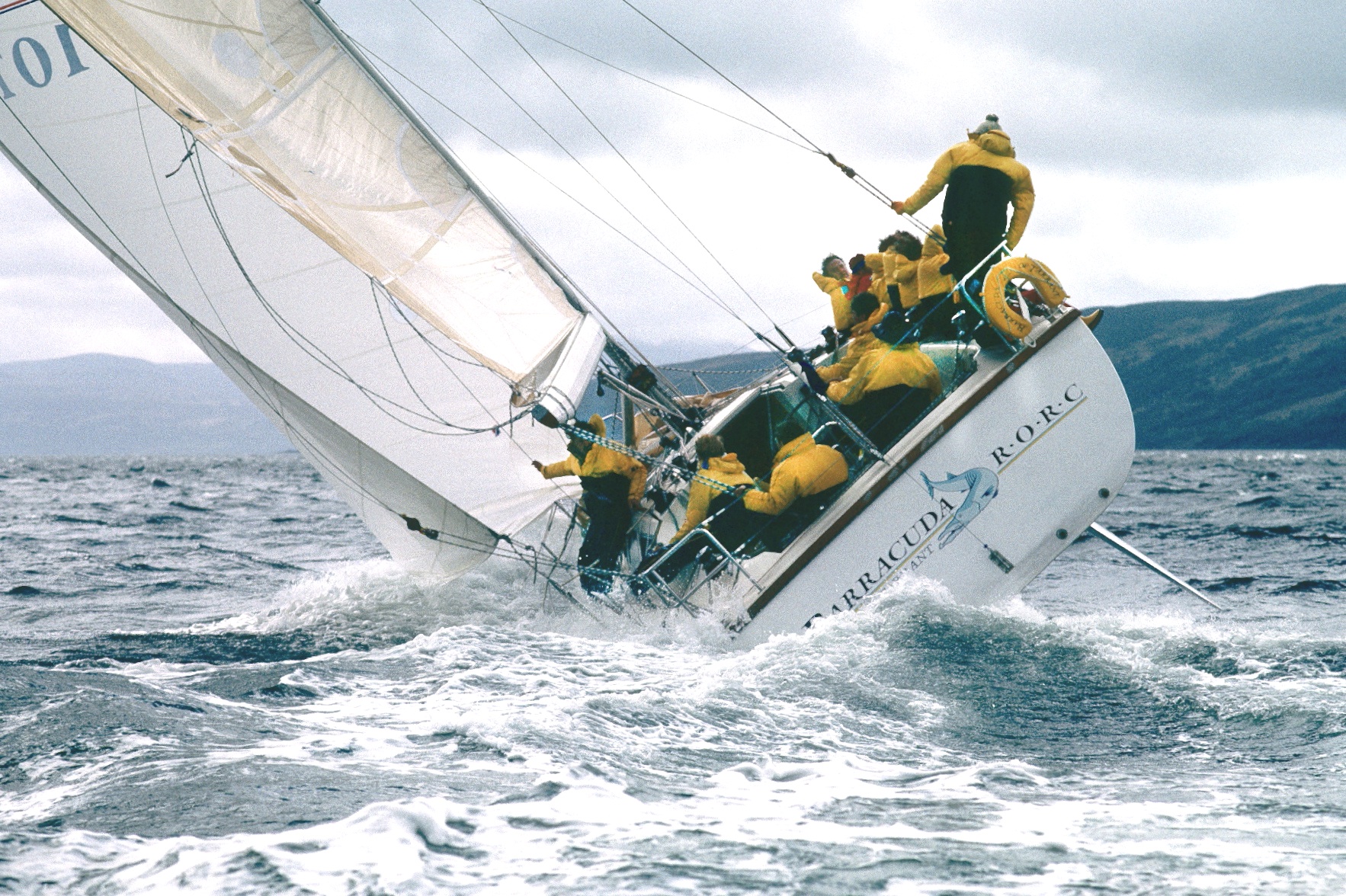
The mighty machine – Barracuda of Tarrant at the Scottish Series 1986. Twenty years before twin rudders became mainstream for large broad-sterned boats in Europe, Tony Castro incorporated them on Bob Fisher's new ULDB. In these squally conditions, a standard broad-sterned yacht of 1986 would have been spinning round to look at herself at frequent intervals. But with the skipper comfortably ensconced at the wheel under his famous black sou'wester, Barracuda tracks as though on rails, with her weather rudder completely clear of the water while her lee rudder is doing the business in a vertical position of maximum efficiency. This design of 29 years ago is still ahead of the game, and it's reckoned a boat built to the same lines and concept, but using the latest construction methods, would be one very potent machine today, Photo: www.patrickroach.com
#AmericasCup - Andrew 'Bart' Simpson died from "blunt trauma with drowning" after the Artemis Sailing catamaran capsized and broke apart during training ahead of the America's Cup this summer.
That was finding of the medical examiner's report into the tragic incident on 9 May released last week, as Euronews reports.
The 36-year-old double Olympic medalist suffered multiple head blows when the 72-foot racing vessel capsized on top of him during a training run on San Francisco Bay.
As previously reported on Afloat.ie, Simpson was trapped beneath the boat and died despite desperate efforts to revive him. All other members of the 11-strong crew of the AC72 were recovered.
However, report into Simpson's death did not establish the exact sequence of events the led to the capsize, nor explain why Simpson was unable to get out from under the vessel.
And its findings have been disputed by Chuck Hawley, one of the America's Cup incident investigation panel, who believes the catamaran's main crossbeam broke before the boat collapsed on itself, trapping Simpson within the structure.
Euronews has much more on the story HERE.
America's Cup. From Isle of Wight to Hamilton Island
#americascup – If the 36th America's Cup is staged at Hamilton Island, it will continue a long story, started from the Isle of Wight in 1851. W M Nixon introduces this exotic venue, then ponders the ultimate seaworthiness of multihulls.
We signed off here on this sailing blog a fortnight ago with the admission that the sacredly monstrous America's Cup in its new form for the 34th Edition has got us hooked, as indicated by our own and general global interest in that key question: "What happens next?" That was Saturday September 28th. We didn't have long to wait. On Monday September 30th, it was announced that Hamilton Island Yacht Club of Australia has been accepted by cup holders Golden Gate Yacht Club as the Challenger of Record for the 35th America's Cup.
Hamilton what? Where island? Is it somewhere comparable to the Isle of Wight, where it all started way back in 1851 with the race round the island for the Hundred Guineas Cup? For once, we were ahead of the posse without having to go to google. Back in 2007, Gordon Maguire was signed up as lead helmsman on Mike Slade's 100ft Leopard for a serious tilt at the Fastnet Race record. But that was the year that the start was postponed for 25 hours because of a Force 9 sou'wester. And Maguire's window of opportunity to do the Fastnet was very narrow, as he was contracted to be at some event called Hamilton Island Race Week to skipper Matt Allen's Ichi Ban immediately afterwards.
He took a look at the new schedules, and reckoned the Fastnet start delay ruled him out, and flew out for Australia. But Leopard still broke the record. Yet all we can really remember about it now is it was the year Ger O'Rourke's Chieftain was Fastnet Race overall winner, and that this Hamilton Island place with its race week must have something very special going for it.
Five years down the line, it's more special than ever. Hamilton Island is owned by veteran campaigner Bob Oatley, a serial entrepreneur whose sailing credentials have been firmly established with a long string of boats called Wild Oats, with his current hundred footer Wild Oats XI holding the Sydney-Hobart Race record. Hamilton Island resort is one of his pet projects. For some of us, the fact that the daytime temperature seldom goes below 26 degrees is a distinct drawback, but others will think it paradise. It's among the Whitsunday Islands on the Great Barrier Reef coast of Queensland, and the Australian distances are enormous – you're talking about a dozen hours of steady driving north from Brisbane.
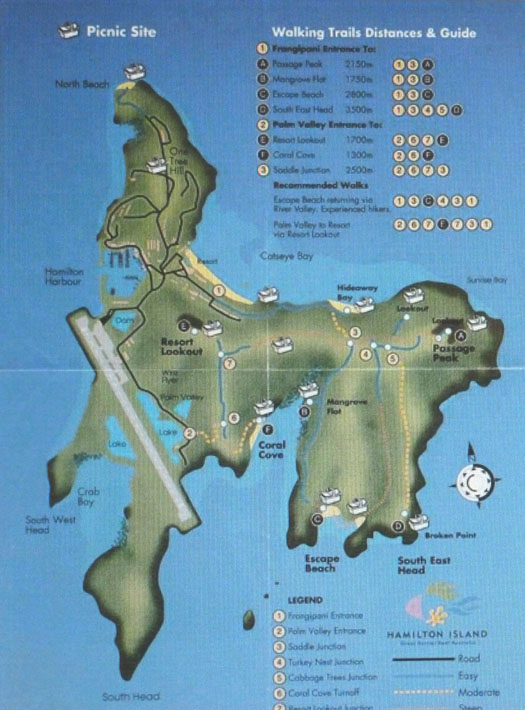
Every America's Cup location should have at least one picnic site. Hamilton Island has all the facilities for the big one
Thus everybody hopes to fly there, as it has its own airport where the runway comes in one side of the island, and goes out the other. It's right beside the harbour, thus it's possible to get sailing immediately to avoid having the temperature floor you. And if you're minded to sail round the island to celebrate getting there, it shouldn't take too long, as Hamilton Island is just three miles long by two miles wide, though it's so indented with bays that it's only two square miles in all, about twice the size of Lambay.
That said, as it's among the coral of the Great Barrier Reef, not all the sailing around Hamilton Island is as straightforward as getting round Lambay. For even if you avoid Plum Pudding Reef and Fitzalan Reef and Hamilton Island Reef itself, and then keep clear of Perseverance Reef and Young Island Reef, there's still Surprise Rock Reef waiting to...well, surprise you.
But the word is the yacht club is very fully appointed, and just itching to host the America's Cup eight years down the line. However, what form the America's Cup will be eight years hence is anyone's guess, and currently it's open season in the global comment and criticism stakes, with advocates of multi-hulls in a defiant "We told you so" frame of mind as the world of sailing grudgingly admits that the 72ft foiling catamarans in the 34th America's Cup brought the thing to life.
Instinctive multi-hull resistance is nothing new. The Polynesians and other Pacific islanders may have been merrily trundling around their nice warm ocean for centuries on multihulls of all types, but attempts to transfer the concept to colder waters failed to do the business for many years. Way back in 1663, that extraordinary polymath William Petty, the man who created the Down Survey which tabulated Ireland, tested his own-designed catamaran Simon & Jude (which he'd had built in Dublin) in the Liffey and on Dublin Bay, and the new machine out-sailed a ship's gig and a "pleasure boatte" of renowned performance. The Simon & Jude was re-created for Hal Sisk by master shipwright John O'Reilly in Dublin in 1991, and a race was staged with one of the Bantry Boats and a little Dutch cutter enthusiastically playing the roles of the opposition, but the S & J outsailed them both.

Ireland's first multi-hull, the Simon & Jude of 1663, was re-created by Hal Sisk in 1991 to re-stage her initial race when she comfortably outsailed a ship's gig, re-enacted here by one of the Bantry boats. Photo: W M Nixon
However, the concept soon came up against the ultimate seaworthiness trial after Petty built The Experiment, a much larger catamaran with accommodation. She certainly outsailed the Dublin-Holyhead packet boat by a significant amount, but failed to return from a test venture into the Bay of Biscay, and the old salts happily stuck with their traditional mono-hull craft.
In subsequent centuries the idea arose again from time to time, and in 1870 a Belfast amateur sailor, John MacKenzie, created the 21ft Jumelle, with a twin hulls of sufficiently modern appearance to make the classic 1870s gaff cutter rig fitted to her seem bizarre. By all accounts she could sail well in a straight line – speeds of ten knots were reported – but despite it being a time when yachting was developing rapidly, the people spending the money were notably conservative, and the Belfast Lough yachting establishment stayed determinedly with their mono-hulled cutters, schooners, ketches and yawls.
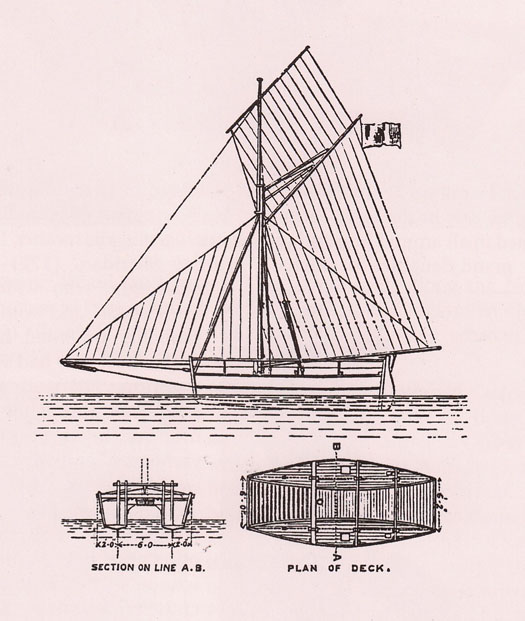
John MacKenzie of Belfast designed and built the 21ft catamaran Jumelle in 1870, and achieved speeds of 10 knots.
This conservatism was also found in America. When the 28-year-old designer Nathanael Herreshoff turned up with his new catamaran Amaryllis for the American Centennial Regatta at Staten Island in 1876 and won in very convincing style, catamarans were promptly banned from all future events. But in truth it was only with the development of lighter building methods and more advanced engineering that multihulls could really show their full potential, and it wasn't until the 1960s with innovators such as the late great Dick Newick that serious offshore racing multihulls finally began to gain traction.
Let's face it, we'd all love multihulls and would happily tear about the seas with them, if two very fundamental problems could be solved. Firstly, how do you find a berth for them when they're twice the area of monohulls of similar size, and sometimes aren't the best at manoeuvring in confined space. And secondly, how can you get round the fact that they are even more stable upside down than they are right way up, and are completely lacking in the mono-hull's self-righting ability?
Putting these problems aside for the moment, there are some very attractive cruising multihulls, and for some time – particularly before I got hip and knee replacements when boats heeling over used to be a pain – I fancied, and still do, the Dragonfly range built in Denmark. We've something of an inside track on the Dragonfly 920 as two of the Howth diaspora, Johnny Malcolm and Black Bob Fannin, crew with Roland Sharp who has his Dragonfly 920 Ischnura based in the Thames Estuary, and they have now and again speeded round to Cowes to do the Round the Island Race with quite a modicum of success.
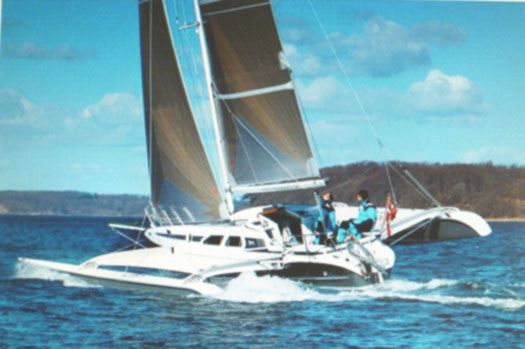
The Danish-built trimaran Dragonfly 920 is one of Europe's most successful multihull performance cruisers
In 2011 they won the multihull division, and last year they came second. That race of 2012 was memorable, as Ben Ainslie was helming the mighty Eleanor, the re-creation of the legendary Westward, the 135ft Herreshoff schooner of 1910 vintage. This awesome vessel started in the early morning before the multihulls, slugging westward down the Solent in majestic style, but the cheeky little Ischnura was past her before the Needles despite breaking a jib sheet which cost her the win in her class, but she still was a good second.
This gives a hint of the Dragonfly's performance potential. She was hitting 15 to 20 knots comfortably round the back of the island, and having started at 0600, they'd finished the 50-mile circuit course by 1130. Ischnura is the version known as the Dragonfly 920 EX (which is Extreme if you really want to know), but though she's optimised for performance with extra sail area, she still has the advantage of being based around a single central hull which can be utilised to provide much better accommodation than a catamaran of the same 30ft size, for it's said that you need to go to 40ft or even 50ft before you can start putting decent accommodation in a catamaran.
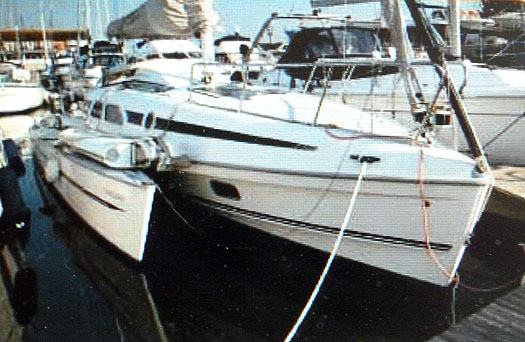
Berthing problems solved. The Dragonfly can fold her wings.
Thanks to swing wings, the Dragonfly range can halve their beam to come into a marina berth. The builders claim it can all be done from the cockpit taking a minute for each side, which is probably rather faster than the raising of the bowsprit by a gaffer in order to reduce overall length for berthing purposes. So with beam reduced and a light overall weight, the Dragonfly is also a proposition for easy trailing. In all, an attractive package, but building light and strong is expensive, as is providing the engineering for the swing wings, so it has to be faced that an almost-new Dragonfly 920EX sold recently for €142,000, which you can compare at your leisure with boats of similar accommodation, and reach your own conclusions.
But putting the price aside, and having dealt with the berthing problem, what's the situation regarding scary sailing? This week's vid of Jeanne-Pierre Dick's MOD 70 capsizing is a reminder of the ultimate vulnerability of multihulls, but in sailing Ischnura in a wide variety of situations, Johnny Malcolm says he has never felt cause for alarm, while the enjoyment factor as she ramps up the speed is fantastic. But he did mention that he wasn't aboard when Roland Sharp and Black Bob Fannin were tearing past the North Foreland in wind over tide and carrying the spinnaker in rather more wind than they should, and they did have a megafright, but lived to tell the tale.
But following the capsize of a Dragonfly 28 in the Round the Island race, the boat's enthusiasts – and they are many – simply stated that it's a fact of life: if you drive any trimaran too hard, you're going to capsize. However, it's when multi-hulls are sitting becalmed and get hit by a sudden gust that their ultimately non-self-righting characteristics can become unexpectedly evident. In the more mountainous parts of Scotland's West Coast, where the hills are high but the waters narrow, multihulls have had their problems. One of the most squally places is Loch Scathvaig, which thrusts deep into the Cuilins of Skye. A Dragonfly 28 sitting totally becalmed here was reported pitch-poled by a katabatic blast, and the water being deep, went completely upside down.
You don't need to be right under the heights of the Cuilins in order to experience sudden gusts of real power. Just round the corner and up the southeast coast of Skye along the Sound of Sleat is Isle Ornsay, a lovely spot whose only disadvantage is that when the wind is from the east, it can come storming across the Sound big time out of the brooding mountains of Loch Hourn, and sudden easterly squalls seemingly out of nowhere are another Hourn treat.
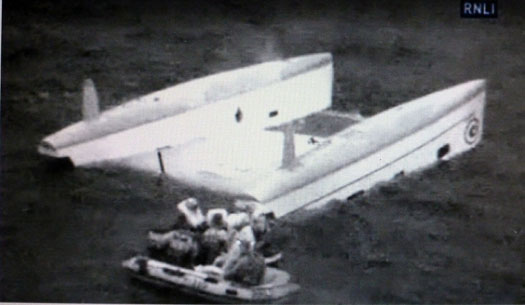
Horrid end to a lovely day.....the new Pampero TS52 is flippd by a sudden squall in the Sound of Sleat, 1st August 2012
In 2012, a big new French cruising catamaran, a 52ft Pampero TS, was sitting flat becalmed off Isle Ornsay. The name of the marque proved an unfortunate choice. A Loch Hourn pampero squall arrived with a bang. Before she could get moving to improve sail carrying power, and before anyone could get to the mainsheet, she was upside down.
Everyone was taken off safely, and within days an ace Isle Ornsay team led by Pete Fowler had righted her and brought her into Mallaig. We happened to call by that fine port a few days later on our way back from the Outer Hebrides, and as our skipper Dickie Gomes used to be a multhull ace with the 40ft Northern Ireland-built Newick trimaran Downtown Flyer (we'll return to that story another day), we were interested to hear his views on the big salvaged boat in the quayside yard.
My word, she was big. Enormous. The mast alone was like a round tower or a minaret. And with everything on the boat and about her, there was a feeling of the suddenness of it all, the total upset to a pleasant day. We came upon two or three salt-stained playing cards scattered in the cockpit. The vision of a sophisticated French charter party leisurely playing cards with highly intellectual conversation and then – zap – came irresistibly to mind. The imagination was enough. Even our skipper, seldom at a loss for words, had little to say.
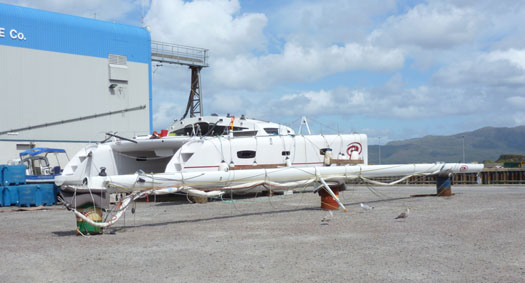
At first glance the salvaged catamaran in Mallaig seemed to show few signs of her capsize.......Photo: W M Nixon
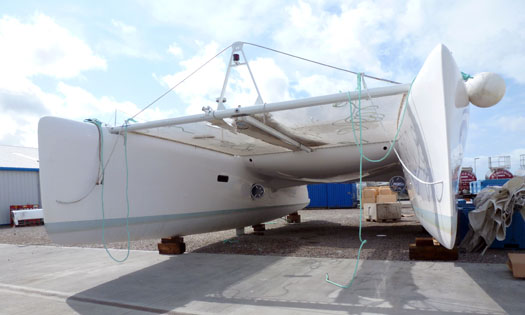
...and gave all the impressions of being a powerful fast cruiser....Photo: W M Nixon
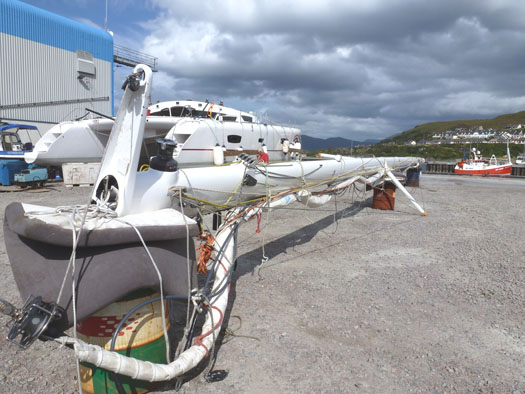
....but soon the evidence could be discerned....Photo: W M Nixon
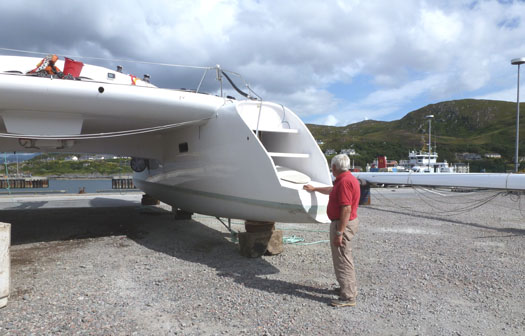
...and then everywhere we found signs of sudden catastrophe. Photo: W M Nixon
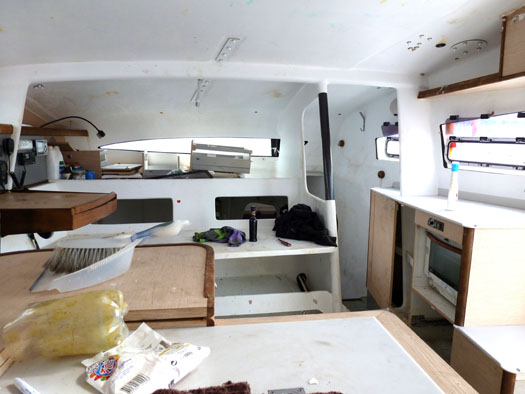
It was clear how spacious and stylish the big saloon had been....Photo: W M Nixon
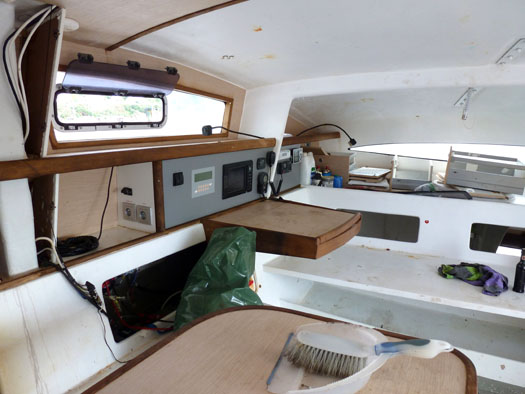
.....with its stylishly planned layout now damaged by oil and water Photo: W M Nixon
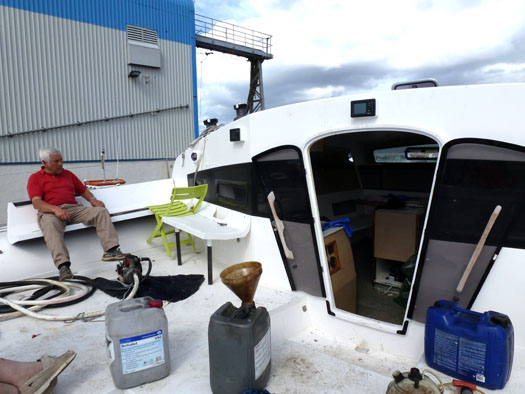
Our skipper, formerly a very determined offshore multihull racer, was for once lost for words. Photo: W M Nixon
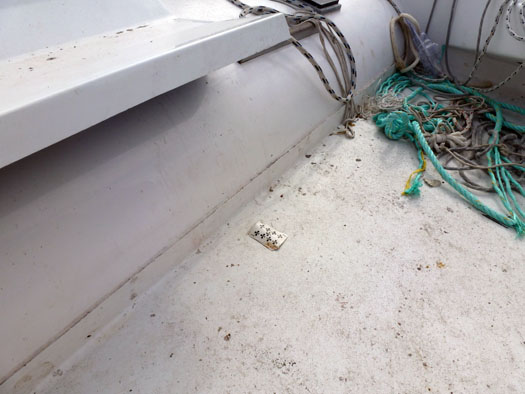
It was easy to imagine how peaceful things had been before the squall struck. The charter party may even have been playing a game of cards in the cockpit......Photo: W M Nixon
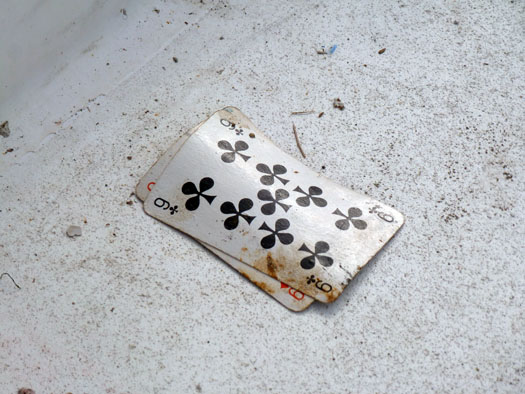
A pity. It had the makings of a good hand. Photo: W M Nixon
So even the big expensive multihulls have this ultimate drawback. There's no way around it, offshore multihulls should carry a health warning. But the rewards of living with the risk are fantastic sailing, and an ability to eat up the miles on passage in a style which leaves much larger craft in the ha'penny place.
The fact that it's decidedly different from orthodox sailing is all part of the package in making the America's Cup excitingly exotic. It needs multi-hulls, and it needs a bit of size. They talk of making them more affordable in order to attract more teams o the next series. But "more affordable" suggests smaller. Surely they couldn't be think of going below 60ft? And no doubt when the bubbles have settled a bit, some bright spark will say that the only way to maintain the excitement is to make the next generation 90ft.
Whatever, it's a long way over 162 years from the Isle of Wight to Hamilton Island. And it's a long way from he robust ocean-crossing schooner America to the extraordinary machines that captured global imagination in September. What happens next?
Ben Ainslie Talks His Role In America's Cup Turnaround
#AmericasCup - Fresh off of helping comeback kids Oracle Team USA to the America's Cup in San Francisco last week, Britain's Olympic sailing superstar Sir Ben Ainslie gets the profile treatment in The Guardian this weekend.
Credited by many with the astonishing turnaround in Oracle's fortunes as they trailed Emirates Team NZ by one race win to eight in the first-to-nine contest, Ainslie is nonetheless discreet about the achievement, reminding interviewer Sam Wollaston: "There were 120 guys on the team and 11 of us on the water. It's certainly not about individuals. I'm not just trying to be modest."
'Sir Ben' feels he's matured over his long top-flight sailing career - dating back to his silver medal win in Atlanta in 1996 aged just 19 - and no longer turns "into a bit of a monster on the water".
And at least the Olympic gold medallist recognises what everybody else can see in him - that he's able to "produce the best performances under pressure, when things aren't going that well. I love the challenge, being on the back foot."
The Guardian has much more on the story HERE.
America's Cup Deserves the Nobel Peace Prize
#americascup – The America's Cup is still sailing's sacred monster. More so than ever, in fact. And it is still something of which we can honestly say: "This is the peak of world sailing – alas". But after the fantastic 34th America's Cup series in San Francisco, there's no denying it has us hooked.
How can we be so sure? There's a simple test. Anyone who took the slightest interest in it now asks: "What happens next?" Once you're getting that response from people, whether they are sailors or sports fans or simply good old Joe Public who just happened to catch it on a news flash, then you've got them hooked, and you can build on that for the future of the event.
So from being something which was only the highly specialised interest of an elite minority, it has become a supercharged happening from which everyone can take something. My own conversion came not from contemplating the seemingly endless intrigues which surrounded the event, and not from its extraordinary history of larger-than-life characters and even more off-the-wall boats, but simply from watching the vids of the giant catamarans racing, just like anyone else in an increasingly rapt global audience.
It's amazing to think that in a couple of years time and probably much sooner, we will take it for granted that a machine like Oracle USA can be powered up to sail to windward at 32.5 knots. And that done in a true wind of 17 knots. It meant that those on board were experiencing an apparent wind of upwards of Force 10.
And as for the way these 72ft boats rose on their foils, we may have had glimpses of it in the preliminaries, but when it is happening as a regular occurrence you begin to feel you're not looking at a boat at all, but at an utterly sensational magic carpet. Sailing became three dimensional as they shook off the grip of the sea. One can only reflect that the great G L Watson, who was the first designer to become obsessed about the need to reduce wetted area, would have been ecstatic.
And all this technical stuff is over and above the basic human interest, and the allocating of credit where credit is due. For sure, the introduction of Ben Ainslie as tactician into Jimmy Spithill's Oracle USA team made a significant difference. But it's pitching it a bit high to say that Sir Ben saved the America's Cup for Larry Ellison. Rather, he was a major component in a complex process of continuous improvement in every area, in a campaign which cleverly utilised every opportunity for scrounging extra time in order to maximise the boat's performance and thereby upset Team New Zealand's seemingly unassailable points lead.
Thus any sailor with an under-performing boat can take encouragement from the fact that when the finals began, the Kiwi boat was simply out-performing Oracle. But in the nail-biting final race, after endless round-the-clock work on the American boat, the reverse was true. Tactically, it was the New Zealanders who were on top of the game to establish an early advantage in that final race. But once they were fully into the beat, Oracle simply sailed round them and on into a solid lead.
That it's suggested that this turnaround is something which can be an inspiration to any sailor may seem far-fetched when we consider just how remote the America's Cup catamarans are from the kinds of boats and the sort of sailing the rest of us enjoy. But that is the measure of this series – there was something in it for everyone.
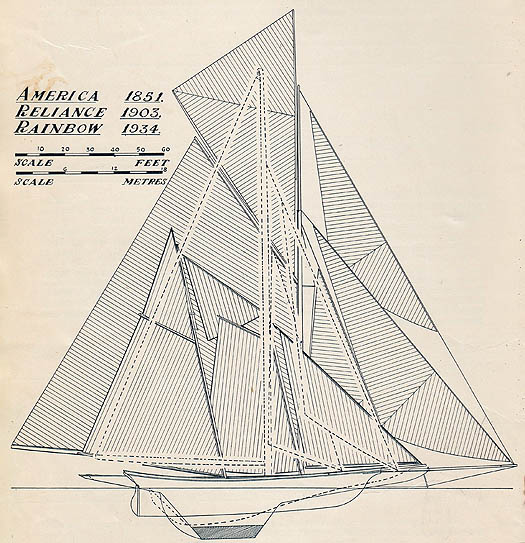
Three America's Cup winners, all to the same scale. Reliance of 1903 was the largest boat which has ever raced for the cup. At 143ft LOA, she was just one foot short of being twice the length of the current class of catamarans.
Not least of the impressions it leaves is the completely supra-national nature of it all. This genuine globalisation of sport is surely for the ultimate good of mankind. Officially it was New Zealand challenging America for an international trophy which originated in Britain 162 years ago. But what we might call the America's Cup community is now a supra-national grouping of hyper-talent drawn from many corners of the globe. Just which ensign goes up the winner's flagpole at the conclusion of the event depends on the nationality of whoever is signing the cheques. But the sailors themselves are patriots for their sport rather than the representatives of some narrow jingoist concept of nationality.
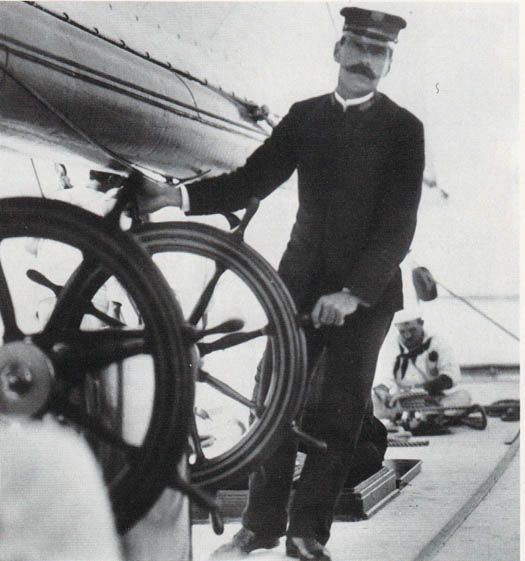
The main man. Charlie Barr on the helm of the giant Reliance, which had double wheels for extra power when needed. Barr was a Scotsman who became American as his sailing career reached the heights.
This is something which has long been central to the America's Cup, and it's all the better for it. After all, one of the greatest skippers in the history of the trophy was Charlie Barr, a Scotsman who settled in America after he had delivered a Clyde-built yacht across the Atlantic, and reached his full potential sailing American defenders of the cup.
More recently the Swiss involvement in the series emphasised just how meaningless traditional concepts of nationality can be. That said, we still do need some notion of nationhood in order to give us a better understanding of the human condition. The America's Cup's ability to transcend national feeling, while at the same time feeding a sense of national pride, is a remarkable achievement. It may seem a crazy idea, but why not consider it for the Nobel Peace Prize?
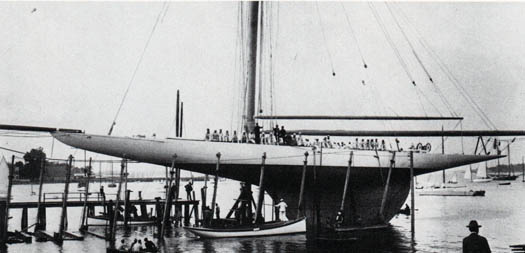
Launching day for Reliance, which carried a racing crew of 60......
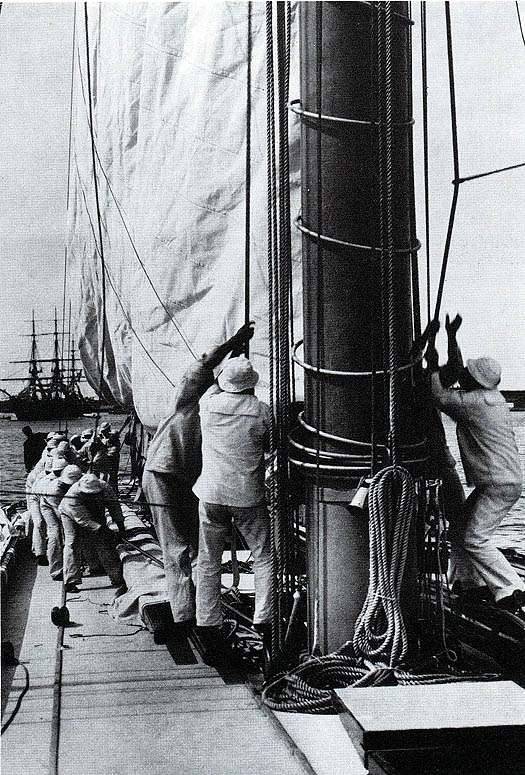
....and even with them all at work, hoisting Reliance's mainsail took quite some time. After defeating Thomas Lipton's Shamrock III by 3-0 in 1903, the Cornelius Vanderbilt-owned Reliance was dismantled, as her hull was built in so many different metals that it is said she hissed when put afloat.
As for its place in the global sailing community, it is currently very secure. We can't be certain that some future series will not draw the cup and our sport back into discredit, but for now we can be confident that the America' Cup has fulfilled all the hype, and then some. And by being something which is at a stratospheric height by comparison with almost all other forms of sailing, it now has the odd effect of making ordinary sailors feel more in community with the rest of the world. We reckon the America's Cup is just as crazy as everyone else does. But it certainly has got us hooked.
Comeback Kings Oracle Team USA Win America's Cup
ORACLE TEAM USA won the 34th America's Cup in a winner-take-all 19th race, defeating challenger Emirates Team New Zealand by 44 seconds in today's clincher. Led by 35-year-old skipper Jimmy Spithill, ORACLE TEAM USA won by the score of 9-8.
This is the second America's Cup win for ORACLE TEAM USA and Spithill, which won the 162-year-old trophy in Valencia, Spain, in February 2010. Then 30 years of age, Spithill became the youngest to ever skipper a Cup winning team.
In the past week ORACLE TEAM USA has steadily improved its boatspeed to the point where it could hydrofoil upwind at 30-32 knots, incredible performance never seen before in the America's Cup.
ORACLE TEAM USA's victory marks one of the most improbable comebacks in the history of sport. The team won 11 races to score the 9 points required for victory due to a penalty imposed by the International Jury. Just last Wednesday, Sept. 18, ORACLE TEAM USA trailed the series 8-1. With the challenger on match point, the defender closed out the series with eight consecutive victories.
This was the third time in the history of the America's Cup with a winner-take-all final race. Previously, the defender won in 1920 and the challenger won in 1983. Both times the winner rallied from a multi-race deficit, but never anything amounting to eight straight wins.
Race 19 Performance Data
- Course: 5 Legs/10.07 nautical miles
- Elapsed Time: OTUSA - 23:24, ETNZ - 24:08
- Delta: OTUSA +:44
- Total distance sailed: OTUSA - 11.9 NM, ETNZ - 12.2 NM
- Average Speed: OTUSA - 30.55 knots (35 mph), ETNZ - 30.55 knots (35 mph)
- Top Speed: OTUSA - 44.33 knots (51 mph), ETNZ - 45.72 knots (53 mph)
- Windspeed: Average - 18.2 knots, Peak - 21.3 knots
- Number of Tacks/Jibes: OTUSA - 9/7, ETNZ - 9/7







































































